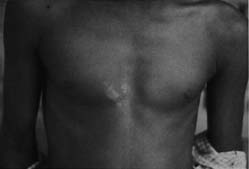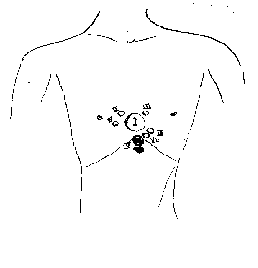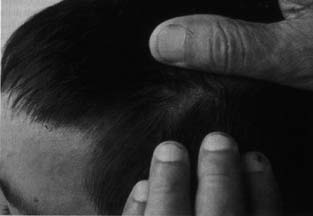Dr. Ian Stevenson
This article by Dr. Ian Stevenson, published in an academic journal in 1993, provides amazing graphic evidence that physical traits somehow can carry over from a past life to a present life. It's also a sample of Dr. Stevenson's thoroughness, and of his academic style. It's not easy reading. But it is, in my opinion, the strongest proof yet of reincarnation.
The "forthcoming book" that Dr. Stevenson mentions, and on which this article is based, is now available. It's huge, more than 2200 pages. If you want to dig into this amazing work further, I recommend you get the shorter summary book, Where Biology and Reincarnation Intersect from Amazon.com.
Following is the complete text of the article.
* * * * * * * *
"Birthmarks and Birth Defects Corresponding to Wounds on Deceased Persons"
By Dr. Ian Stevenson
Dr. Ian Stevenson is the head of the Department of Psychiatric Medicine at the University of Virginia School of Medicine, Charlottesville, Virginia.
This paper was presented at the Eleventh Annual Meeting of the Society for Scientific Exploration held at Princeton University. June 11-13, 1992.
Abstract
Almost nothing is known about why pigmented birthmarks (moles or nevi) occur in particular locations of the skin. The causes of most birth defects are also unknown. About 35% of children who claim to remember previous lives have birthmarks and/or birth defects that they (or adult informants) attribute to wounds on a person whose life the child remembers. The cases of 210 such children have been investigated. The birthmarks were usually areas of hairless, puckered skin; some were areas of little or no pigmentation (hypopigmented macules); others were areas of increased pigmentation (hyperpigmented nevi). The birth defects were nearly always of rare types. In cases in which a deceased person was identified the details of whose life unmistakably matched the child's statements, a close correspondence was nearly always found between the birthmarks and/or birth defects on the child and the wounds on the deceased person. In 43 of 49 cases in which a medical document (usually a postmortem report) was obtained, it confirmed the correspondence between wounds: and birthmarks (or birth defects). There is little evidence that parents and other informants imposed a false identitmarks and birth defects.y on the child in order to explain the child's birthmark or birth defect. Some paranormal process seems required to account for at least some of the details of these cases.
Figure 1.
Hypopigmented macule on chest of an Indian youth who, as a child, said he remembered the life of a man, Maha Ram, who was killed with a shotgun fired at close range.
Figure 2
The circles show the principal shotgun wounds on Maha Ram, for comparison with Figure 1. [This drawing is from the autopsy report of the deceased.]
Introduction
Although counts of moles (hyperpigmented nevi) have shown that the average adult has between 15 and 19 of them (Pack and Davis, 1956), little is known about their cause -- except for those associated with the genetic disease neurofibromatosis -- and even less is known about why birthmarks occur in one location of the body instead of in another. In a few instances a genetic factor has been plausibly suggested for the location of nevi (Cockayne, 1933; Denaro, 1944; Maruri, 1961); but the cause of the location of most birthmarks remains unknown. The causes of many, perhaps most, birth defects remain similarly unknown. In large series of birth defects in which investigators have searched for the known causes, such as chemical teratogens (like thalidomide), viral infections, and genetic factors, between 430/0 (Nelson and Holmes, 1989) and 65 -- 70% (Wilson, 1973) of cases have finally been assigned to the category of "unknown causes."
Among 895 cases of children who claimed to remember a previous life (or were thought by adults to have had a previous life), birthmarks and/or birth defects attributed to the previous life were reported in 309 (35%) of the subjects. The birthmark or birth defect of the child was said to correspond to a wound (usually fatal) or other mark on the deceased person whose life the child said it remembered. This paper reports an inquiry into the validity of such claims. With my associates I have now carried the investigation of 210 such cases to a stage where I can report their details in a forthcoming book (Stevenson, forthcoming). This article summarizes our findings.
Children who claim to remember previous lives have been found in every part of the world where they have been looked for (Stevenson, 1983; 1987), but they are found most easily in the countries of South Asia. Typically, such a child begins to speak about a previous life almost as soon as it can speak, usually between the ages of two and three; and typically it stops doing so between the ages of five and seven (Cook, Pasricha, Samararatne, Win Maung, and Stevenson, 1983). Although some of the children make only vague statements, others give details of names and events that permit identifying a person whose life and death corresponds to the child's statements. In some instances the person identified is already known to the child's family, but in many cases this is not so. In addition to making verifiable statements about a deceased person, many of the children show behavior (such as a phobia) that is unusual in their family but found to correspond to behavior shown by the deceased person concerned or conjecturable for him (Stevenson, 1987; 1990).
Although some of the birthmarks occurring on these children are "ordinary" hyperpigmented nevi (moles) of which every adult has some (Pack and Davis, 1956), most are not. Instead, they are more likely to be puckered and scarlike, sometimes depressed a little below the surrounding skin, areas of hairlessness, areas of markedly diminished pigmentation (hypopigmented macules), or port-wine stains (nevipammri). When a relevant birthmark is a hyperpigmented nevus, it is nearly always larger in area than the "ordinary" hyperpigmented nevus. Similarly, the birth defects in these cases are of unusual types and rarely correspond to any of the "recognizable patterns of human malformation" (Smith, 1982).
Methods
My investigations of these cases included interviews, often repeated, with the subject and with several or many other informants for both families. With rare exceptions, only firsthand informants were interviewed. All pertinent written records that existed, particularly death certificates and postmortem reports, were sought and examined. In the cases in which the informants said that the two families had no previous acquaintance, I made every effort to exclude all possibility that some information might nevertheless have passed normally to the child, perhaps through a half-forgotten mutual acquaintance of the two families. I have published elsewhere full details about methods (Stevenson, 1975; 1987).
I did not accept any indicated mark as a birthmark unless a firsthand witness assured me that it had been noticed immediately after the child's birth or, at most, within a few weeks. I enquired about the occurrence of similar birth marks in other members of the family; in nearly every instance this was denied, but in seven cases a genetic factor could not be excluded.
Birth defects of the kind in question here would be noticed immediately after the child's birth. Inquiries in these cases excluded (again with rare exceptions) the known causes of birth defects, such as close biological relationship of the parents (consanguinity), viral infections in the subject's mother during her pregnancy, and chemical causes of birth defects like alcohol.
Results
Correspondences between Wounds and Birthmarks
A correspondence between birthmark and wound was judged satisfactory if the birthmark and wound were both within an area of 10 square centimeters at the same anatomical location; in fact, many of the birthmarks and wounds were much closer to the same location than this. A medical document, usually a postmortem report, was obtained in 49 cases. The correspondence between wound and birthmark was judged satisfactory or better by the mentioned criterion in 43 (88%) of these cases and not satisfactory in 6 cases. Several different explanations seem to be required to account for the discrepant cases, and I discuss these elsewhere (Stevenson. forthcoming). Figure 1 shows a birthmark (an urea of hypopigmentation) on an Indian child who said he remembered the life of a man who had been killed with a shotgun fired at close range. Figure 2 shows the location of the wounds recorded by the pathologist. (The circles were drawn by an Indian physician who studied the postmortem report with me.)
The high proportion (88%) of concordance between wounds and birthmarks in the cases for which we obtained postmortem reports (or other confirming documents) increases confidence in the accuracy of informants' memories concerning the wounds on the deceased person in those more numerous cases for which we could obtain no medical document. Not all errors of informants memories would have resulted in attributing a correspondence between birth marks and wounds that did nor exist; in four cases (possibly five) reliance on an informant's memory would have resulted in missing a correspondence to which a medical document attested.
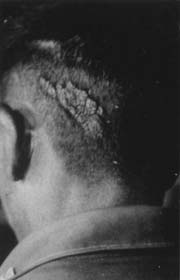 Figure 3
Figure 3
Large verrucous epidermal nevus on head of a Thai man who as a child said he remembered the life of his paternal uncle, who was killed with a blow on the head from a heavy knife.
Cases with Two or More Birthmarks
The argument of chance as accounting for the correspondence between birthmarks and wounds becomes much reduced when the child has two or more birthmarks each corresponding to a wound on the deceased person whose life he claims to remember. Figure 3 shows a major abnormality of the skin (verrucous epidermal nevus) on the back of the head of a Thai man who, as a child, recalled the life of his uncle, who had been struck on the head with a heavy knife and killed almost instantly. The subject also had a deformed toenail of the right great toe (Figure 4). This corresponded to a chronic infection of the same toe from which the subject's uncle had suffered for some years before he died.
Figure 4
Congenital malformation of nail on right great toe of the Thai subject shown in Figure 3. This malformation corresponded to a chronic ulcer of the right great toe from which the subject's uncle had suffered.
The series includes 18 cases in which two birthmarks on a subject corresponded to gunshot wounds of entry and exit. In 14 of these one birthmark was larger than the other, and in 9 of these 14 the evidence clearly showed that the smaller birthmark (usually round) corresponded to the wound of entry and the larger one (usually irregular in shape) corresponded to the wound of exit. These observations accord with the fact that bullet wounds of exit are nearly always larger than wounds of entry (Fatteh, 1976; Gordon and Shapiro, 1982). Figure 5 shows a small round birthmark on the back of the head of a Thai boy, and Figure 6 shows a larger, irregularly shaped birthmark at the front of his head. The boy said that he remembered the life of a man who was shot in the head from behind. (The mode of death was verified, but no medical document was obtainable.) In addition to the 9 cases I have investigated myself, Mills reported another case having the feature of a small round birthmark (corresponding to the wound of entry) and a larger birthmark corresponding to the wound of exit (both verified by a postmortem report) (Mills, 1989).
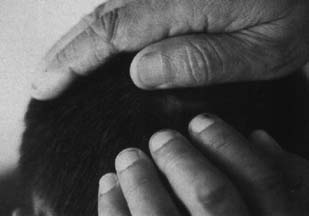 Figure 5
Figure 5
Small, round puckered birthmark on a Thai boy that corresponded to the bullet wound of entry in a man whose life he said he remembered and who had been shot with a rifle from behind.
Figure 6
Larger, irregularly shaped birthmark on the frontal area of the head of the Thai boy shown in Figure 5. This birthmark corresponded to the bullet wound of exit on the Thai man whose life the boy said he remembered.
I have calculated the odds against chance of two birthmarks correctly corresponding to two wounds. The surface area of the skin of the average adult male is 1.6 meters (Spalteholz, 1943). If we were to imagine this area square and spread on a fiat surface, its dimensions would be approximately 127 centimeters by 127 centimeters. Into this area would fit approximately 160 squares of the size 10 centimeters square that I mentioned above. The probability that a single birthmark on a person would correspond in location to a wound within the area of any of the 160 smaller squares is only 1/160. However, the probability of correspondences between two birthmarks and two wounds would be (1/160)2 i.e. 1 in 25,600. (This calculation assumes that birthmarks are uniformly distributed over all regions of the skin. This is incorrect [Pack, Lenson, and Gerber, 1952], but I believe the variation can be ignored for the present purpose.)
Examples of Other Correspondences of Detail between Wounds and Birthmarks
A Thai woman had three separate linear hypopigmented scarlike birthmarks near the midline of her back; as a child she had remembered the life of a woman who was killed when struck three times in the back with an ax. (Informants verified this mode of death, but no medical record was obtainable.) A woman of Burma was born with two perfectly round birthmarks in her left chest; they slightly overlapped, and one was about half the size of the other. As a child she said that she remembered the life of a woman who was accidentally shot and killed with a shotgun. A responsible informant said the shotgun cartridge had contained shot of two different sizes. (No medical record was obtainable in this case.)
Another Burmese child said that she remembered the life of her deceased aunt, who had died during surgery for congenital heart disease. This child had a long, vertical linear hypopigmented birthmark close to the midline of her lower chest and upper abdomen; this birthmark corresponded to the surgical incision for the repair of the aunt's heart. (I obtained a medical record in this case.) In contrast, a child of Turkey had a horizontal linear birthmark across the right upper quadrant of his abdomen. It resembled the scar of a surgeon's transverse abdominal incision. The child said that he remembered the life of his paternal grandfather, who had become jaundiced and was operated on before he died. He may have had a cancer of the head of the pancreas, but I could not learn a precise medical diagnosis.
Two Burmese subjects remembered as children the lives of persons who had died after being bitten by venomous snakes, and the birthmarks of each corresponded to therapeutic incisions made at the sites of the snakebites on the persons whose lives they remembered. Another Burmese subject also said as a child that she remembered the life of a child who had been bitten on the foot by a snake and died. In this case, however, the child's uncle had applied a burning cheroot to the site of the bite -- a folk remedy for snakebite in parts of Burma; and the subject's birthmark was round and located at the site on the foot where the bitten child's uncle had applied the cheroot.
Three Examples of Birth Defects
Figure 8, below, shows the right side of the head of a Turkish boy with a diminished and malformed ear (unilateral microtia). He also had underdevelopment of the right side of his face (hemifacial microsomia). He said that he remembered the life of a man who had been shot (with a shotgun) at point-blank range. The wounded man was taken to a hospital where he died 6 days later -- of injuries to the brain caused by shot that had penetrated the right side of the skull. (I obtained a copy of the hospital record.)
 Figure 8
Figure 8
Severely malformed ear (microtia) in a Turkish boy who said that he remembered the life of a man who was fatally wounded on the right side of the head by a shotgun discharged at close range.
Figure 9 shows fingers almost absent congenitally on one hand (unilateral brachydactyly) in a child of India who said he remembered the life of another child who had put his right hand into the blades of a fodder-chopping machine and lost his fingers. Most cases of brachydactyly involve only a shortening of the middle phalanges. In the present case there were no phalangeal bones, and the fingers were represented by mere stubs. Unilateral brachydactyly is exceedingly rare, and I have not found a published report of a case, although a colleague (plastic surgeon) has shown me a photograph of one case that came under his care.
 Figure 9
Figure 9
Almost absent fingers (brachydactyly) on one hand in a boy of India who said he remembered the life of a boy of another village who had put his hand into the blades of a fodderchopping machine and had its fingers amputated.
Figure 10 shows congenital absence of the lower right leg (unilateral hemimelia) in a Burmese girl. She said that she remembered the life of a girl who was run over by a train. Eyewitnesses said that the train severed the girl's right leg first, before running over the trunk. Lower hemimelia is an extremely rare condition, and Frantz and O'Rahilly (1961) found it in only 12 (4.0%) of 300 cases of all congenital skeletal deficiencies that they examined.
 Figure 10
Figure 10
Congenital absence of lower leg (unilateral hemimelia) in a girl of Burma who said she remembered the life of a young woman who was accidentally run over by a train, with her right leg being severed first.
Discussion
Because most (but not all) of these cases develop among persons who believe in reincarnation, we should expect that the informants for the cases would interpret them as examples according with their belief; and they usually do. It is necessary, however, for scientists to think of alternative explanations.
The most obvious explanation of these cases attributes the birthmark or birth defect on the child to chance, and the reports of the child's statements and unusual behavior then become a parental fiction intended to account for the birthmark (or birth defect) in terms of the culturally accepted belief in reincarnation. There are, however, important objections to this explanation. First, the parents (and other adults concerned in a case) have no need to invent and narrate details of a previous life in order to explain their child's lesion. Believing in reincarnation, as most of them do, they are nearly always content to attribute the lesion to some event of a previous life without searching for a particular life with matching details. Second, the lives of the deceased persons figuring in the cases were of uneven quality both as to social status and commendable conduct. A few of them provided models of heroism or some other enviable quality; but many of them lived in poverty or were otherwise unexemplary. Few parents would impose an identification with such persons on their children. Third, although in most cases the two families concerned were acquainted (or even related), I am confident that in at least 13 cases (among 210 carefully examined with regard to this matter) the two families concerned had never even heard about each other before the case developed. The subject's family in these cases can have had no information with which to build up an imaginary previous life which, it later turned out, closely matched a real one. In another 12 cases the child's parents had heard about the death of the person concerned, but had no knowledge of the wounds on that person. Limitations of space for this article oblige me to ask readers to accept my appraisal of these 25 cases for this matter; but in my forthcoming work I give a list of the cases from which readers can find the detailed reports of the cases and from reading them judge this important question for themselves. Fourth, I think I have shown that chance is an improbable interpretation for the correspondences in location between two or more birthmarks on the subject of a case and wounds on a deceased person.
Persons who reject the explanation of chance combined with a secondarily confected history may consider other interpretations that include paranormal processes, but fall short of proposing a life after death. One of these supposes that the birthmark or birth defect occurs by chance and the subject then by telepathy learns about a deceased person who had a similar lesion and develops an identification with that person. The children subjects of these cases, however, never show paranormal powers of the magnitude required to explain the apparent memories in contexts outside of their seeming memories.
Another explanation, which would leave less to chance in the production of the child's lesion, attributes it to a maternal impression on the part of the child's mother. According to this idea, a pregnant woman, having a knowledge of the deceased person's wounds, might influence a gestating embryo and fetus so that its form corresponded to the wounds on the deceased person. The idea of maternal impressions, popular in preceding centuries and up to the first decades of this one, has fallen into disrepute. Until my own recent article (Stevenson, 1992) there had been no review of series of cases since 1890 (Dabney, 1890); and cases are rarely published now (Williams and Pembroke, 1988). Nevertheless, some of the published cases -- old and new -- show a remarkable correspondence between an unusual stimulus in the mind of a pregnant woman and an unusual birthmark or birth defect in her later-born child. Also, in an analysis of 113 published cases I found that the stimulus occurred to the mother in the first trimester in 80 cases (Stevenson, 1992). The first trimester is well known to be the one of greatest sensitivity of the embryo/fetus to recognized teratogens, such as thalidomide (Nowack, 1965) and rubella (Hill, Doll, Galloway, and Hughes, 1958). Applied to the present cases, however, the theory of maternal impression has obstacles as great as the normal explanation appears to have. First, in the 25 cases mentioned above, the subject's mother, although she may have heard of the death of the concerned deceased person, had no knowledge of that person's wounds. Second, this interpretation supposes that the mother not only modified the body of her unborn child with her thoughts, but after the child's birth influenced it to make statements and show behavior that it otherwise would not have done. No motive for such conduct can be discerned in most of the mothers (or fathers) of these subjects.
It is not my purpose to impose any interpretation of these cases on the readers of this article. Nor would I expect any reader to reach even a preliminary conclusion from the short summaries of cases that the brevity of this report entails. Instead, I hope that I have stimulated readers to examine the detailed reports of many cases that I am now in the process of publishing (Stevenson, forthcoming). "Originality and truth are found only in the details" (Stendhal, 1926).
Acknowledgements
I am grateful to Drs. Antonia Mills and Emily W. Cook for critical comments on drafts of this paper. Thanks are also due to the Bernstein Brothers Parapsychology and Health Foundation for the support of my research.
References
Cockayne, E, A. (1933). Inherited abnormalities of the skin. London: Oxford University Press.
Cook, E. W., Pasricha, S, Samararatne, G, Win Maung, & Stevenson, I. (1983). Review and analysis of "unsolved" cases of the reincarnation type: II. Comparison of features of solved and unsolved cases, Journal of the American Society for Psychical Research, 77, 1 15-135.
Dabney, W. C. (1890). Maternal impressions. In J. M. Keating (Ed.), Cyclopaedia of the diseases of children, Vol. 1 , (pp. 191-216). Philadelphia: J. B. Lippincott.
Denaro, S. J. ( 1944). The inheritance of nevi. Journal of Heredity, 35, 2 1 5- 1 8.
Fatteh, A. (1976). Medicolegal investigation ofgunshor wounds. Philadelphia: J. B. Lippincott.
Frantz, C. H., & O'Rahilly, R.(1961). Congenital skeletal limb deficiencies. Journal ofBone and Joins Surgerq: 43-A, 1202-24.
Gordon, I., & Shapiro, H. A. (1982). Forensic medicine: A guide to principles. (2nd ed.) London: Churchill Livingstone.
Hill, A, B,, Doll, R,, Galloway, T. M., & Hughes, J.P.W. (1958). Virus diseases in pregnancy and congenital defects. British Journal of Preventive and Social Medicine, 12, 1-7.
Maruri, C. A. (1961). La herencia en dermarologia. (2nd ed.) Santander: Aldus, S.A. Artes Graficas.
Mills, A. (1989). A replication study: Three cases of children in northern India who are said to remember a previous life. Journal of Scientific Exploration, 3, 133-184.
Nelson, K., & Holmes, L. B. (1989). Malformations due to presumed spontaneous mutations in newborn infants. New England Journal ofMedicine, 320, 19-23.
Nowack, E, (1965). Die sensible Phase bei der Thalidomid- Embryopathie. Humangenetik, I, 516-36.
Pack, G. T., & Davis, J. (1956). Moles. New York Stare Journal ofMedicine, 56, 3498-3506.
Pack, G. T., Lenson, N. & Gerber, D. M. (1952). Regional distribution of moles and melanomas. AMA Archives ofSurgery. 65, 862-70.
Smith, D. W. (1982). Recognizable patterns of human malformation. (3rd ed.) Philadelphia: W. B·Saunders.
Spalteholz. W· (1943). Hand atlas of human anatomy. Translated by L. E Barker. 7th English ed. Philadelphia: J,B. Lippincott.
Stendhal (1926). Lucien Leuwen. Paris: Librairie Ancienne Honor6 Champion, 4, 169.
Stevenson, I. (1975). Cases of the reincarnation type. I. Ten cases in India. CharlottesviIle: University Press of Virginia.
Stevenson, I. (1983). American children who claim to remember previous lives. Journal ofNervous and Mental Disease, 17 1, 742-748.
Stevenson, I. (1987). Children who remember previous lives. Charlottesville: University Press of Virginia.
Stevenson, I. ( 1990). Phobias in children who claim to remember previous lives. Journal of Scientific Exploration, 4, 243-254.
Stevenson, I. (1992). A new look at maternal impressions: An analysis of 50 published cases and reports of two recent examples. Journal of Scientific Exploration, 6, 353-373.
Stevenson, I. (Forthcoming). Birthmarks and birth defects: A contribution to their etiology.
Williams, H. C., & Pembroke, A. C. (1988). Naevus of Jamaica. Lancer, 11, 915.
Wilson, J. G. (1973). Environment and birth defects. New York: Academic Press.
* * * * * * * *
 Published in the Journal of Scientific Exploration, Vol 7, No.4, pp403-410, 1993. Copyright © 1993 Society for Scientific Exploration.
Published in the Journal of Scientific Exploration, Vol 7, No.4, pp403-410, 1993. Copyright © 1993 Society for Scientific Exploration.
The Society for Scientific Exploration gives voice to scientific issues that are not explored or published by most mainstream scientific journals. It is an organization worth supporting. For more information, see their website: Journal for Scientific Exploration
